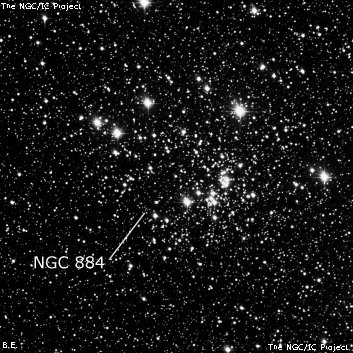chi Persei Cluster
chi Persei Cluster

Hipparchus catalogued the Double Cluster about 130 BC and Ptolemy copied it into his Almagest: "At the tip of the right hand [of Perseus] and nebulous [or misty]." Giovanni Battista Hodierna (1654) resolved the double cluster into stars. William Herschel logged NGC 884 = H VI-34 on 1 Nov 1788 (sweep 877) as "A very beautiful, brilliant cluster of large stars irregularly round, very rich, near one-half degree in diameter." John Herschel noted on 9 Dec 1831 (sweep 387) that "a fine ruby star in the centre". The cluster was examined at Birr Castle looking for colored stars and five red stars were reported and one with a bluish tinge.
200/250mm - 8" this is the eastern component of the "double cluster". Very bright, large, very rich, ~20' diameter, ~60 stars, includes bright colored stars, many doubles.
400/500mm - 17.5" (10/25/97): the following group of the remarkable field of the "double cluster" is not as large or bright as NGC 869, but is centered around two wide triple stars. The central 5' has up to 50 stars including a number of faint mag 14-15 stars forming a rich background. Off the west end of the central region is a long string of stars which heads NE for 10' towards 3 brighter stars and then turning south and heading back past mag 8 orange-red RS Persei. The 20' field includes ~200 stars, although the cluster includes fewer bright stars as NGC 869 and is less compressed.
Notes by Steve Gottlieb